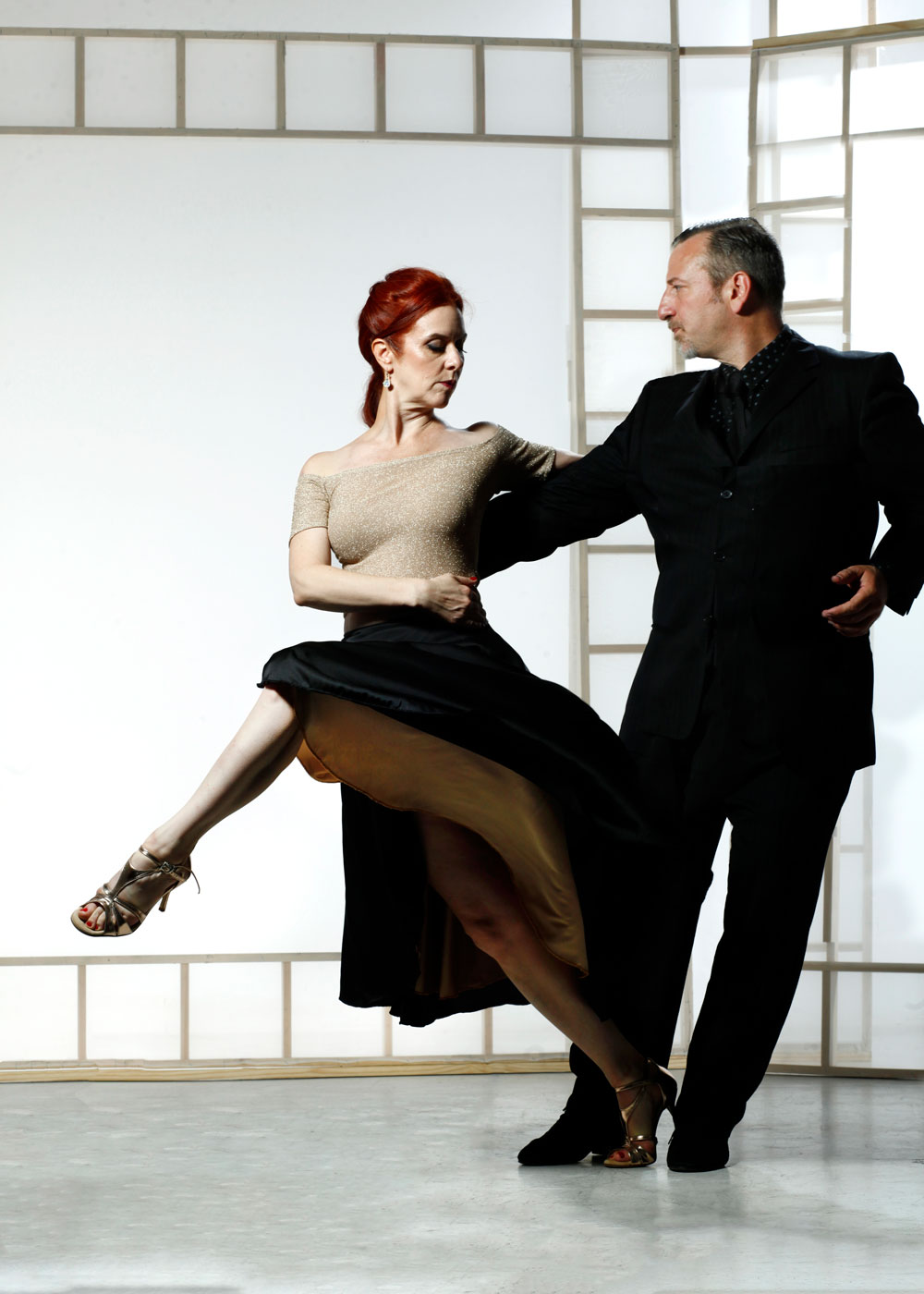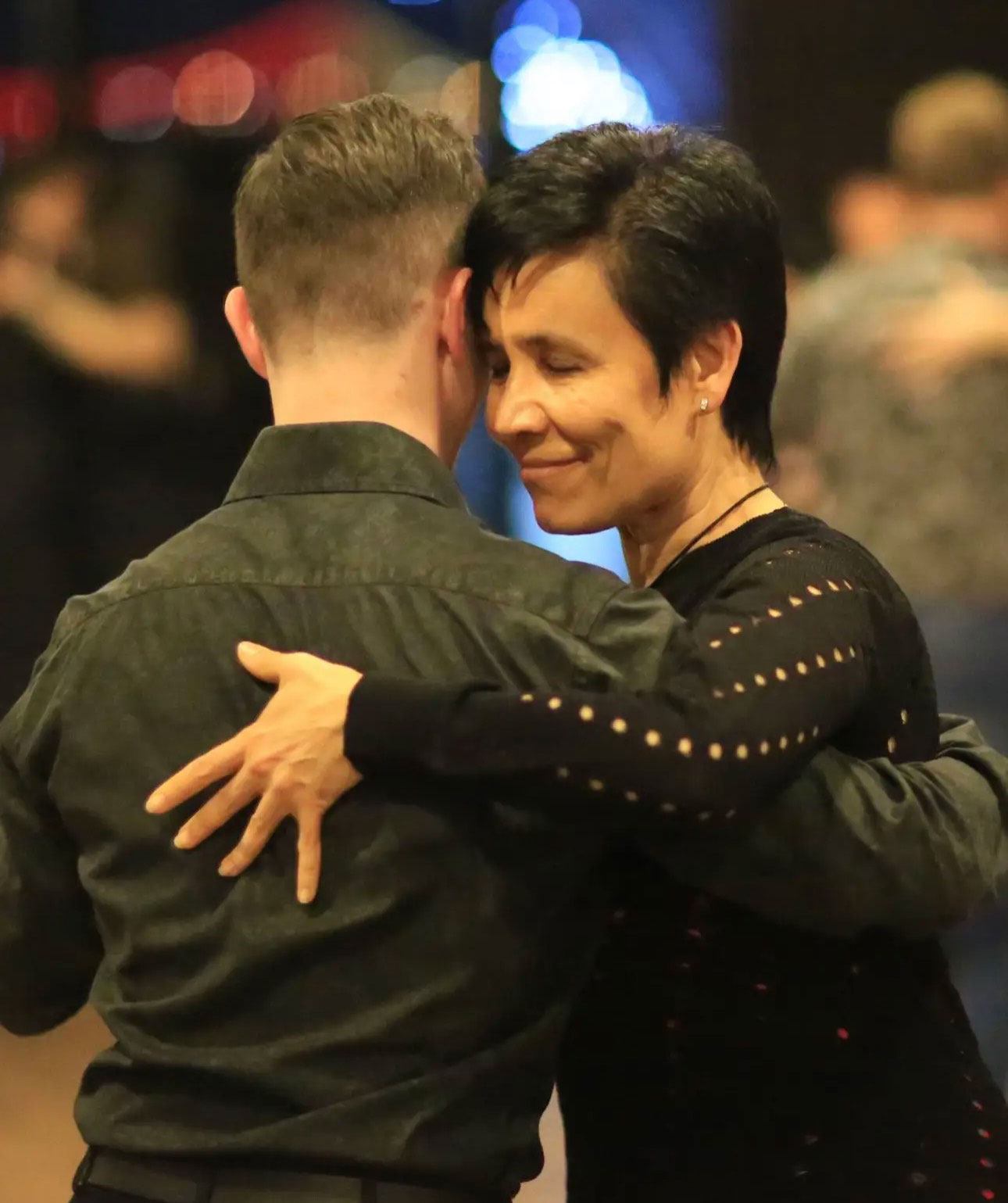
April 2025
Wendy Schneider
Once again, I find myself in wallflower mode at a tango milonga—a social dance gathering where partners move in close embrace to the rhythms of Argentine tango. As I wait for a leader to meet my gaze with a cabaceo—the subtle invitation exchanged through eye contact and a nod—I scan the room, watching the predominantly Russian-speaking dancers pair up, part, and find new partners. Seeking a sense of connection, I find myself wondering how many of them might be Jewish?
Tango is one of the most demanding dance forms to master. It’s humbling and hard on the ego, but it’s also profoundly fulfilling, and the closest I’ve ever come to pure bliss. Perhaps that’s why, for the past nine years, I’ve been drawn to fellow Jewish tango enthusiasts, eager to understand why this dance speaks so deeply to my Jewish soul.
That was the impetus of my reaching out to Meredith Klein during the COVID-19 pandemic. The executive director of the Philadelphia Argentine Tango School had given a presentation in an online webinar I had stumbled upon about her encounters with Jewish Argentinian tango dancers in Buenos Aires. Intrigued, I reached out to her for an interview. We spoke over Zoom in August 2020, where Klein graciously shared her tango journey with me.
Her introduction to Argentine tango came in 1997 while studying music theory at Amherst College, igniting a passion that led her to spend several years honing her skills in studios and festivals across the United States. In 2005, she finally set off on her long-awaited journey to Buenos Aires—just weeks after a devastating nightclub fire claimed 200 lives. With tango venues temporarily closed pending city inspections, Klein feared her dream of dancing in Buenos Aires might slip away during her brief three-week stay. However, the shutdown launched an array of underground and outdoor tango events that brought people together outside their comfort zones and opened the doors to rapid and profound relationship-building.
“A lot of the dancers I met that night were Jewish,” she told me, “When my ancestors fled Lithuania, they could have just as easily ended up in Buenos Aires instead of the United States.”
Klein’s ancestors were part of a massive wave of Eastern European Jewish migration between 1881 and 1914, fleeing persecution and economic hardship in Russian-controlled territories. During this period, two million Jews sought refuge in the United States, while approximately 300,000 made new lives in Canada, South Africa, South America and Palestine. Those who disembarked along the Río de la Plata—the river separating Argentina and Uruguay—settled in the working-class slums of Buenos Aires and Montevideo, alongside other European immigrants, formerly enslaved Africans, and Argentina’s labouring poor.
In the brothels and nightclubs of these working-class neighbourhoods, the tango was born—a fusion of African, European and New World influences, carried by the melancholic strains of the violin and the bandoneón, a German-imported, accordion-like instrument. At times, it was danced by pairs of men; at others, by prostitutes and their companions. Among those who found themselves entangled in this world were immigrant Jewish women, many of whom had been coerced into working in legalized brothels. At the same time, a significant number of the musicians shaping the sound of early tango were Jewish, weaving their own musical influences into its evolution.
Scholars have long observed the striking similarities between klezmer and tango, highlighting their shared use of expressive ornamentation, intricate rhythms, and vocal cadences—some reminiscent of cantorial melodies—all of which captured the struggles, sorrows and fleeting joys of everyday life.
The connections Meredith Klein forged on that first, unforgettable night in Buenos Aires two decades ago remain just as strong today—none more so than her partnership with Andres Amarilla, her former dance partner, collaborator and fellow teacher.
Beyond her own journey, Klein is deeply committed to fostering a thriving, inclusive tango community. “We have students who start tango in their late 70s or even 80s without a movement background and are having some success,” she said. “It’s just such a remarkable dance form that if you can manage to keep walking, you know then (that) you can keep dancing this dance forever.”
There’s no doubt that Toronto tango devotee Ilona Milonguera (a pseudonym) is dedicated to dancing tango for life. The Russian-born Jewish dancer has made a notable contribution to the community as the founder of Toronto Tango Junkies, a Facebook group that has become an indispensable resource for tango dancers throughout Southern Ontario. A dynamic, pixie-like force of nature, Ilona is a well-known presence at Toronto milongas, always taking the time to warmly welcome both seasoned dancers and newcomers alike.
llona discovered tango in September 2001. At her very first milonga, she was struck by the sight of a community coming together to celebrate a man’s 93rd birthday. “I remember thinking, wow, you can dance tango and be part of a community like this even at 93.”
The next day was Sept. 11. As the world reeled, one thought kept running through her mind: If everything is falling apart, maybe I just need to dance more.
And dance she did. Determined to master the art, Ilona sought out every tango instructor she could find in Toronto, immersing herself in lessons. In 2004, she made her first trip to Argentina, and since then, she has studied with 150 tango teachers across the globe, and taught the dance in six countries.
Ilona’s paternal grandparents were Hungarian Jews who moved to Belarus in the early 1930s for economic reasons. In 1938, her grandfather was arrested as an enemy of the state and sent to Siberia, never to be heard from again. Her grandmother, father and uncle were the only Jewish family in their town to survive the war, protected by their ability to pass as Hungarians.
Like many Russian Jews of her generation, Ilona didn’t learn about her Jewish heritage until she moved to Canada at the age of 11. “It wasn’t something that we talked about in Russia because it was dangerous for children to know such things,” she says.
Ilona likes to say that her tango journey preceded her birth. Her mother was both a dancer and a musician, while her father was a gifted writer and accomplished musician. Her parents met while playing in an orchestra in Siberia, where Ilona was born. At this point in her story, she reaches for a photograph—her father holding an accordion, her uncle with his violin.
“My father got his first accordion when he was 16,” she says. Inside the case, was a small picture of a dancing couple. Above them, a single word: Tango.
No discussion of the Jewish influences on tango would be complete without mentioning Polish tango—a genre of sentimental songs composed between 1918 and 1939 by classically trained Polish musicians, many of them Jewish. The rebirth of the Polish state in 1918, after 123 years of partitions and conflict, created a fertile ground for the emergence of tango. Infused with klezmer influences that set it apart from the traditional rhythms of Argentine tango. Polish tango developed a distinct style.
History took a devastating turn when Hitler’s troops invaded Poland in 1939, and we know how the story ends.
Polish Jewish violinist Artur Gold, was forced to perform Polish tangos for his captors, dressed as a clown, before his own murder. Renowned tango composer Henryk Gold and a few others saw the danger early and escaped, continuing their musical careers in Israel, New York and Hollywood. But for most, the story of interwar Polish tango ended in unimaginable horror.
They say you don’t find tango—tango finds you. While fate may have introduced me to it, its Jewish influences are what keep drawing me in, again and again. And I wouldn’t have it any other way.


CAPTIONS: Meredith Klein, executive director of the Philadelphia Argentine Tango School and her partner Ignacio Ondartz.
Toronto-based tango dancer Ilona Milonguera enjoys a blissful moment at a milonga in Kyiv, Ukraine in February 2020, just before COVID-19 lockdown.

